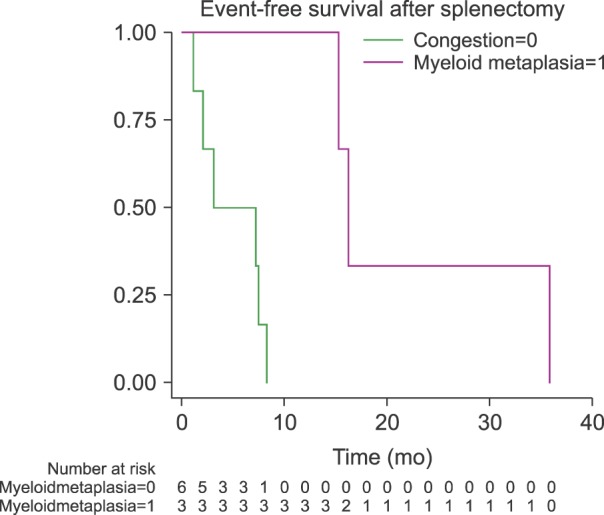Blood Res.
2018 Mar;53(1):35-40. 10.5045/br.2018.53.1.35.
Splenic myeloid metaplasia in warm autoimmune hemolytic anemia (wAIHA): a retrospective study
- Affiliations
-
- 1Hematology and Oncology Department, Instituto Nacional de Ciencias Médicas y Nutrición Salvador Zubirán, Tlalpan, México City, México. vanguianin1@hotmail.com
- 2Médica Sur Foundation and Clinic, Instituto Nacional de Ciencias Médicas y Nutrición Salvador Zubirán, Tlalpan, México City, México.
- 3Pathology Department, Instituto Nacional de Ciencias Médicas y Nutrición Salvador Zubirán, Tlalpan, México City, México.
- KMID: 2414362
- DOI: http://doi.org/10.5045/br.2018.53.1.35
Abstract
- BACKGROUND
Splenic myeloid metaplasia (SMM) is a kind of extramedullary hematopoiesis, whereas its clinical significance in wAIHA remains unclear. The aim of this study is evaluating the frequency and clinical characteristics of SMM, compared with splenic-congestion (SC).
METHODS
We included patients with wAIHA treated in a Mexican tertiary hospital between January 1992 and December 2015. All patients received steroids as first-line treatment and splenectomy as second-line treatment.
RESULTS
Among the thirty-six splenectomized patients, 15 (41.6%) and 21 (58.4%) were diagnosed as SMM and SC, respectively. No differences were found in clinical characteristics between two groups. SMM patients showed lower platelet count (147×109/L vs. 240×109/L, P=0.02) and higher presence of anti-dsDNA antibodies (40% vs. 4.7%, P=0.01) than SC patients. Although the complete response (CR) rate with first-line treatment was lower in SMM patients (13.3% vs. 47.6%; P=0.04), post-splenectomy median disease-free-survival (DFS) was longer (16.2 mo vs. 5.1 mo; P=0.19). Univariate/multivariate analysis showed that achieving CR during first-line treatment (OR 0.3, 95% CI: 0.03-0.94, P=0.03) and higher platelet count (OR 0.99, 95% CI: 0.98-0.99, P=0.03) were protective factors for SMM; and anti-dsDNA titer higher than 9.6 IU/dL was a risk factor for SMM (OR 2.76, 95% CI: 1.48-5.14, P < 0.001).
CONCLUSION
The wAIHA patients with SMM have different biological profiles with those without SMM. This study is the first trial evaluating the significance of histopathological spleen findings and their association with rheumatologic profile.
Keyword
MeSH Terms
Figure
Cited by 1 articles
-
Treatment of autoimmune hemolytic anemia: real world data from a reference center in Mexico
José Carlos Jaime-Pérez, Patrizia Aguilar-Calderón, Lorena Salazar-Cavazos, Andrés Gómez-De León, David Gómez-Almaguer
Blood Res. 2019;54(2):131-136. doi: 10.5045/br.2019.54.2.131.
Reference
-
1. Yang M, Roarke M. Diffuse pulmonary extramedullary hematopoiesis in myelofibrosis diagnosed with technetium-99m sulfur colloid bone marrow scintigraphy and single photon emission computerized tomography/CT. Am J Hematol. 2017; 92:323–324. PMID: 27883206.2. Ahmad K, Ansari S, Koirala R, Agarwal M, Chaudhary S. Paraspinal and presacral extramedullary hematopoiesis: a rare manifestation of polycythemia vera. Iran J Radiol. 2013; 10:164–168. PMID: 24348604.
Article3. Kim CH. Homeostatic and pathogenic extramedullary hematopoiesis. J Blood Med. 2010; 1:13–19. PMID: 22282679.
Article4. Smith JN, Calvi LM. Current concepts in bone marrow microenvironmental regulation of hematopoietic stem and progenitor cells. Stem Cells. 2013; 31:1044–1050. PMID: 23509002.5. Gao JL, Shui YM, Jiang W, et al. Hypoxia pathway and hypoxia-mediated extensive extramedullary hematopoiesis are involved in ursolic acid's anti-metastatic effect in 4T1 tumor bearing mice. Oncotarget. 2016; 7:71802–71816. PMID: 27708244.
Article6. Yam LT, McMillian R, Tavassoli M, Crosby WH. Splenic hemopoiesis in idiopathic thrombocytopenic purpura. Am J Clin Pathol. 1974; 62:830–837. PMID: 4473889.
Article7. O'Malley DP. Benign extramedullary myeloid proliferations. Mod Pathol. 2007; 20:405–415. PMID: 17334344.8. Vardiman JW, Thiele J, Arber DA, et al. The 2008 revision of the World Health Organization (WHO) classification of myeloid neoplasms and acute leukemia: rationale and important changes. Blood. 2009; 114:937–951. PMID: 19357394.
Article9. O'Malley DP, Kim YS, Perkins SL, Baldridge L, Juliar BE, Orazi A. Morphologic and immunohistochemical evaluation of splenic hematopoietic proliferations in neoplastic and benign disorders. Mod Pathol. 2005; 18:1550–1561. PMID: 16118626.10. Alonso HC, Manuel AV, Amir CG, et al. Warm autoimmune hemolytic anemia: experience from a single referral center in Mexico City. Blood Res. 2017; 52:44–49. PMID: 28401101.
Article11. Barcellini W, Fattizzo B, Zaninoni A, et al. Clinical heterogeneity and predictors of outcome in primary autoimmune hemolytic anemia: a GIMEMA study of 308 patients. Blood. 2014; 124:2930–2936. PMID: 25232059.
Article12. Rappaport H, Crosby WH. Autoimmune hemolytic anemia. II. Morphologic observations and clinicopathologic correlations. Am J Pathol. 1957; 33:429–457. PMID: 13424654.13. Breitfeld V, Lee RE. Pathology of the spleen in hematologic disease. Surg Clin North Am. 1975; 55:233–251. PMID: 805474.
Article14. Chang CS, Li CY, Liang YH, Cha SS. Clinical features and splenic pathologic changes in patients with autoimmune hemolytic anemia and congenital hemolytic anemia. Mayo Clin Proc. 1993; 68:757–762. PMID: 8331977.
Article15. Barros MM, Blajchman MA, Bordin JO. Warm autoimmune hemolytic anemia: recent progress in understanding the immunobiology and the treatment. Transfus Med Rev. 2010; 24:195–210. PMID: 20656187.
Article16. Aladjidi N, Leverger G, Leblanc T, et al. New insights into childhood autoimmune hemolytic anemia: a French national observational study of 265 children. Haematologica. 2011; 96:655–663. PMID: 21228033.
Article17. Roumier M, Loustau V, Guillaud C, et al. Characteristics and outcome of warm autoimmune hemolytic anemia in adults: New insights based on a single-center experience with 60 patients. Am J Hematol. 2014; 89:E150–E155. PMID: 24847759.
Article18. Akpek G, McAneny D, Weintraub L. Comparative response to splenectomy in Coombs-positive autoimmune hemolytic anemia with or without associated disease. Am J Hematol. 1999; 61:98–102. PMID: 10367787.
Article19. Domiciano DS, Shinjo SK. Autoimmune hemolytic anemia in systemic lupus erythematosus: association with thrombocytopenia. Clin Rheumatol. 2010; 29:1427–1431. PMID: 20473539.
Article20. Zhang L, Wu X, Wang L, et al. Clinical features of systemic lupus erythematosus patients complicated with Evans syndrome: a case-control, single center study. Medicine (Baltimore). 2016; 95:e3279. PMID: 27082565.21. Sultan SM, Begum S, Isenberg DA. Prevalence, patterns of disease and outcome in patients with systemic lupus erythematosus who develop severe haematological problems. Rheumatology (Oxford). 2003; 42:230–234. PMID: 12595615.
Article
- Full Text Links
- Actions
-
Cited
- CITED
-
- Close
- Share
- Similar articles
-
- Warm autoimmune hemolytic anemia: experience from a single referral center in Mexico City
- A Case of Autoimmune Hemolytic Anemia Caused by Warm Antibody
- Autoimmune Hemolytic Anemia in Children
- Clinical characteristics and treatment outcomes of primary autoimmune hemolytic anemia: a single center study from South India
- A Case of Autoimmune Hemolytic Anemia Induced by Anti-e



